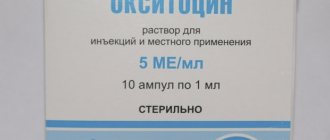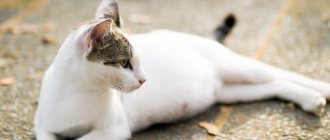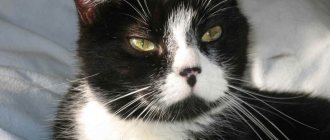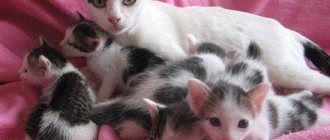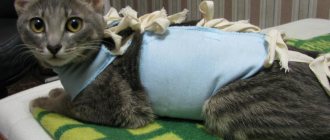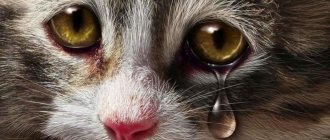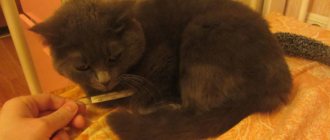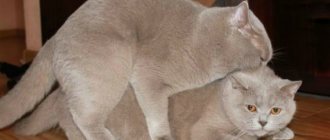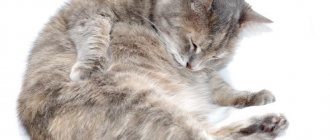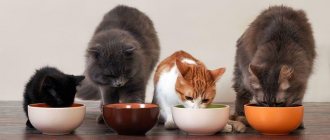Cat food
The cat produces milk immediately after giving birth. This is how nature intended it. Newborn kittens should be fed mother's milk upon birth to get the most out of the antibody-rich colostrum.
In order for milk to appear, you need to feed the nursing mother. Bring some food and water to the animal and place it near her. A cat is unlikely to want to leave her kittens and go far from them to eat. If your cat refuses to eat immediately after giving birth, there is no cause for concern, just offer food a little later.
In order to ensure the health of not only the mother, but also her children, the diet of a nursing cat after birth should be varied and high in calories. Don't limit the serving size. Give as much as he asks. She needs to gain strength.
So, what to feed your cat after giving birth:
- Protein. It is an important building material for any living organism. During the feeding period, part of the supply will be used to produce milk, so you will need to replenish it daily. Give meat, dairy products, fish, eggs.
- Calcium. This element is needed for high-quality milk, as well as to prevent hair loss and tooth decay. Calcium is found in dairy products (milk, kefir, sour cream, cheese).
- Plant products. Oats, lemon balm in milk, cumin, carrots, dandelion - all these plant products will improve lactation.
If a cat refuses to eat after giving birth, then you will need to stimulate her appetite with her favorite food or feed her with a syringe. The animal needs strength and high-quality milk, without which the kittens will simply die.
Natural food products
Products are chosen fresh, rich in proteins, calcium, carbohydrates and beneficial elements.
Among them:
- boiled lean meat: chicken, beef, rabbit, turkey, veal;
- vegetables: beets, pumpkin, cauliflower, carrots, zucchini;
- cottage cheese, curdled milk, natural yoghurts, biokefir;
- cereals: buckwheat, oatmeal, sprouted wheat grains.
To reduce the risk of developing constipation due to intestinal problems, add to the main diet:
- low-fat broths in which meat was cooked;
- warm milk (in small quantities);
- 3 – 4 drops of flaxseed, olive, sesame oil (added to food);
- boiled beets or puree from them;
- young shoots of oats, wheat, barley.
Approximate diet
In the second week of pregnancy, the cat’s appetite increases, therefore the amount of food is increased by 10% of the previous volume, from the second month - by 50%. In the last weeks before childbirth, appetite decreases, it is recommended to reduce portions, and the number of feedings is calculated based on the needs of the expectant mother. An adult animal needs 180-200 grams per day to be satisfied.
After childbirth
Complications after giving birth to a cat can occur at any time. These can be problems of any nature. Quite often, a cat does not have milk after giving birth. However, there is no need to worry about the first three days, because colostrum comes first, and it is quite enough to feed newborns. The presence of milk must be stimulated by good nutrition and calmness of the animal itself.
If the kittens still don’t get enough to eat and are constantly screaming, then you will have to supplement them with boiled cow’s or goat’s milk from a pipette
If a cat is restless after giving birth, behaves strangely, and constantly meows, this may mean that something hurts. Mastitis in cats is a common problem. When there is too much milk and babies do not have time to eat it, then it accumulates and turns sour. In this case, the animal will also need your help. Express it a little and carry out the necessary hygiene procedures.
In addition, you may observe diarrhea in your cat after giving birth, however, this is normal. Postpartum diarrhea can be caused by emotional shock after an experience or poor quality feeding.
What to do if maternal instinct is violated?
If the cat was very exhausted from childbirth, or when the last one was frankly difficult and unsuccessful, your pet may simply not have the strength left to care for her offspring. In these cases, the role of “nanny” will have to be taken on by the owner himself.
We have already described above exactly how cats do this in natural conditions. Remember that you need to “imitate” maternal care as carefully as possible, without rushing.
So, the following is required of you:
- Gently remove the remaining membranes, wipe the kitten's nose and open the mouth, then slightly tilt the pet's head down and try to remove all the liquid and mucus from there.
- If the cat has not chewed off the umbilical cord either, measure about two centimeters from the kitten’s navel, tie the umbilical cord with silk thread, and then cut the “lace” (of course, over the knot you tied). The stump must be lubricated with alcohol tincture of iodine. Please note that you cannot simply cut the umbilical cord! We have already written that when a cat bites it, it simultaneously crushes the edges of the organ, thereby preventing the development of bleeding. If you simply cut the umbilical canal, your baby may bleed to death within minutes.
The most difficult thing is when the kitten is not breathing: perhaps he was born tail first and managed to drink in the amniotic fluid. If medical assistance is not provided immediately, the baby may die from suffocation. You can try to remove the liquid using the smallest baby syringe.
Experienced veterinarians advise using a urinary catheter connected to a regular syringe. In addition, you can massage the kitten’s throat, trying to induce a cough (if you’re lucky, the animal itself will spit out all the excess).
Rocking is another simple, but still quite effective method of resuscitation. To do this, place the kitten in your palm with its back facing down and squeeze its head (gently) between your thumb and index finger. After this, it is necessary to rock the baby for about five minutes, and at this time the hand should make movements like a rocking cradle. During motion sickness, fluids entering the respiratory tract will fluctuate and irritate the corresponding receptors. The latter stimulate coughing and, if the kitten is lucky, it will spit out all the excess.
Keep in mind that you shouldn’t pretend to be a centrifuge with your hand: you certainly won’t do anything better for the baby, but it’s quite possible to cause a hemorrhage in the cerebellum.
Normal discharge
After the birth of kittens, the owner must carefully monitor the temperature and discharge of his pet. The birth of kittens ends with discharge. Initially they may be brown or streaked with blood - this is normal.
Postpartum discharge from the loop is an integral part of the body’s recovery. After childbirth, the uterus contracts and expels clear mucus residue. This can last up to three weeks. Veins and a greenish tint in some cases can be considered normal, and in some cases they can be life-threatening. Here you will need the help of a doctor.
Dangerous discharge from a cat after giving birth
Sometimes it happens that childbirth ends in complications. This occurs due to infection or tissue damage (rupture of tracts). The first sign of dangerous consequences may be a cat’s bloody discharge with an unpleasant odor after giving birth. Bleeding should not last more than 10 minutes. If after this time there is still bloody discharge, then your pet already needs professional help.
Remember, it is difficult to confuse such bleeding with normal discharge. With pathological discharge, the blood is bright scarlet, possibly with the presence of a large number of clots. Normal discharge is brown.
A cat with complications will be constantly in a recumbent state. Don't give her the opportunity to get up. Let him lie there until the doctors arrive. If there is bleeding, the first thing you need to do is take the cat's temperature. If there is no increase in temperature, perhaps the bleeding is due to incomplete disposal of the placenta, a dead fetus (the kitten died in utero) or unsanitary conditions. Scarlet blood with green streaks requires urgent veterinary attention.
Diagnostic measures
The veterinarian will need a complete medical history of the birth (how it went, whether the animal received obstetric care, etc.). A thorough medical examination is required to confirm/refute acute metritis based on clinical signs.
Timely diagnostic tests play a huge role in diagnosis. These include: complete blood count, blood chemistry profile, serology and urinalysis.
The most revealing may be a complete microscopic blood test : by the number of leukocytes, you can determine how intense the inflammatory process is in the animal’s body. In addition, a microscopic examination can show whether pathogenic microflora has appeared in the general bloodstream (i.e., whether sepsis has developed).
A urine test will allow the veterinarian to know how well the animal's kidneys are working and whether the cat has become severely dehydrated.
Ultrasound and fluoroscopic examination of the uterus itself is also indicated . This helps to visually assess the condition of the organ, the presence or absence of retained placenta, dead fetuses, blood or exudate. If there is discharge from the external genitalia, a specialist will definitely take a sample of the exudate for microscopic examination and sowing of the pathological material onto nutrient media. This will help, firstly, to identify the specific pathogen. Secondly, this way the specialist will find out which drug should be used to eliminate this particular case of infection.
Therapeutic techniques
- To help the animal's body cope with the consequences of dehydration, as well as intoxication, Ringer's and glucose solutions . This is an important part of the treatment of any severe case of postpartum endometritis. In addition, timely administration of intravenous infusions helps protect the kidneys.
- Antibiotics . Ideally, drugs are prescribed only based on the results of growing a culture of pathogens on nutrient media. If for some reason this cannot be done, broad-spectrum antibiotics are prescribed. But it is still better to identify a specific pathogen. It is possible that an inexpensive and “light” drug will be suitable for its destruction.
- The most difficult treatment will be in cases where it comes to the development of a septic process. In such situations, the cat urgently needs competent veterinary care, since the likelihood of death is very high. Loading doses of broad-spectrum antibiotics intravenously, drugs that support cardiac and respiratory activity, and intravenous infusions are required
- Surgical intervention . If the uterus is greatly enlarged and there is a suspicion of pyometra, the uterus must be urgently removed. In the event that the owners or veterinarians did not inspect it, and there is an afterbirth or dead fruits left in the organ cavity, it must be removed immediately, since any delay guarantees the development of a severe septic process. Spaying is also recommended. In some cases (when the cat has a certain breeding value) they resort to surgical cleansing of the uterine cavity. Please note that no one can give any guarantee of the success of this operation. Most likely, the cat will still develop severe metritis, after which bearing full-fledged kittens may be impossible.
Please note that after antibiotic therapy, the animal will most likely develop dysbiosis due to the death of the symbiotic intestinal microflora.
As a consequence, constipation and all other problems arising from the fact of constant intoxication of the body by deposits of feces. It wouldn't hurt to give her probiotics.
You also need to remember the need to isolate newborn kittens from their mother: antibacterial drugs or pathogens can enter their digestive tract. In any case, this will not lead to anything good. And further. Even in cases where the pet received quality veterinary care on time, it is far from certain that its reproductive function will be fully restored.
Dangerous postpartum hemorrhage
If postpartum bleeding turns yellowish, gray or cloudy green, then this indicates an inflammatory process of the uterus or its walls. Such manifestations can lead to the death of your pet, so you cannot do nothing. If the diagnosis shows that the lesions are serious, then the cat will have the uterus removed.
Symptoms of acute inflammation:
- increased body temperature;
- apathy and lethargy;
- abandonment of offspring;
- complete loss of appetite.
Complications immediately after childbirth can lead to the development of dangerous diseases. This could be pyometra or endometritis. With the latter, the cat screams loudly, arches its back and tries to sit up. In case of illness, kittens are taken from their mother and fed artificially.
You should also not ignore discharge that has a pungent, rotting or sour odor. Call a veterinarian to your home as soon as possible.
Symptoms of eclampsia in cats
Eclampsia is a disease in which a cat experiences a critical decrease in calcium in the blood plasma after giving birth. At increased risk are primiparas, animals with multiple pregnancies and already mature cats. In addition, the disease develops against the background of unbalanced feeding, when the pet’s diet contains few foods containing calcium (dairy products).
Eclampsia in cats after birth has pronounced signs. They are impossible not to notice. The first thing you may notice is the new mother's anxiety. She is trying to hide the kittens; she will constantly drag them somewhere. Or it could be the other way around – complete abandonment of offspring.
Main symptoms:
- apathy;
- pallor of the mucous membranes and conjunctiva;
- rapid breathing;
- increased salivation;
- refusal of any food;
- temperature increase.
All these manifestations will be of an increasing nature. It will be necessary to notice this behavior and condition of the animal in time and consult a doctor.
Prevention of complications
With the onset of the postpartum period, it is important to provide first aid to the animal in case of deviations from the norm or disturbances in the cat’s well-being. It is important to make sure that all babies have been born and to gently palpate the abdomen to diagnose a remaining placenta or an unborn kitten. It is necessary to pay attention to all the changes that occur with your pet, monitor the emotional state, body temperature, and the presence of discharge.
Note! You should not pick up kittens again. This causes stress for the mother.
Near the nest with kittens you need to place all the attributes necessary for a new mother - a toilet, a bowl of food, clean drinking water.
Endometritis
There are many factors that threaten the life of a giving birth cat. If after giving birth a cat's discharge turns white, you should be wary, because it could be endometritis. Endometritis is a disease characterized by the development of an inflammatory process of the uterine mucosa. This condition is fraught not only with further infertility, but also with the death of the animal.
Symptoms of endometritis:
- thirst or refusal to eat;
- lethargy and apathy;
- body temperature is increased;
- the animal is in search of a cool place;
- the fur under the tail is wet;
- pain in the abdomen due to which the animal screams painfully;
- milk disappears;
- abandonment of kittens (often the cat throws them out of the nest).
White discharge in cats after birth occurs due to infection of the genital organs with fungi, streptococci, and E. coli.
Vaginitis
A very common postpartum pathology. This is the name for inflammation of the vaginal tissue . The reasons are varied, but they are not particularly “cunning”: during childbirth, it often happens that the mucous membrane of the genital organs is damaged, as a result of which the likelihood of pathogenic and conditionally pathogenic microflora penetrating there sharply increases. This is almost always how cases of inept obstetric care end.
If you do not have the appropriate experience and knowledge, do not try to help your pet in labor (most likely, she does not need it). You are unlikely to be able to help, but you can do a lot of harm!
The clinical picture is not very specific, which is why vaginitis is often confused with endometritis. The cat becomes lethargic, does not want to take care of the kittens, and a large amount of exudate (often very odorous) is released from its external genitalia. In addition, upon external examination, swelling of the genital organs and pain when attempting to palpate them may be detected.
Therapy is also not particularly rich in options - broad-spectrum antibiotics are prescribed in loading doses. Preferably intravenously. Ringer's and glucose solutions are administered in the same way, as they help relieve intoxication (and in case of severe inflammation, it will certainly appear).
Pyometra
Postpartum pyometra is a complex pathological disease that cannot be ignored. There is no point in treating the disease; you need to immediately take the cat for surgery. This is the only way you can save your pet’s life.
There are many reasons for the development of the disease. These are mainly birth injuries, a weak immune system, lack of sterility during childbirth and, as a result, infection. Pyometra is accompanied by inflammation and accumulation of pus and mucus in the uterus. The inflammatory process then spreads throughout the reproductive system.
Main symptoms:
- swelling and enlargement of the labia;
- anxiety;
- thirst;
- refusal to eat;
- polyuria;
- rapid breathing;
- temperature;
- trembling in the body.
The disease develops rapidly and it is difficult not to notice its development. The cat breathes frequently and licks its fur to such a state that bald spots appear.
Silence in the house!
A cat's maternal instinct can fail due to human fault. Newborns attract too much attention. Curious children often gather around them, make noise around their beloved pets, fuss, and pick up kittens. Such unnecessary intervention can easily cause a cat’s psycho-emotional disorder and, as a result, its rejection of its offspring.
You should not provoke trouble in the cat family. The best manifestation of care and attention from a person to pets is to create a favorable environment for them in the house, avoid stressful situations, protect the nest from external stimuli, and darken its location. In such a house the animal will feel calm and safe, and the kids will grow up in normal conditions.
Sterilization of a cat after birth
The question of sterilizing cats comes to mind for many owners. Especially if such a need arose immediately after childbirth. Is it possible to sterilize and how long after birth can a cat be sterilized? There is no clear answer. This depends on several factors, the first of which is feeding the kittens. If a pet feeds its offspring, then veterinarians recommend waiting 2-3 months.
Sterilization of cats after birth is not carried out immediately for two reasons:
- If you start the procedure immediately after lambing, the walls of the uterus will lose their elasticity, and this can lead to complications for the health and life of the animal.
- Spaying during postpartum heat is dangerous, as it carries a huge risk of infection.
If two individuals of the opposite sex live in the house, and you want to protect the cat from unwanted pregnancy, then it is worth castrating the male.
Veterinarians advise spaying immediately after the end of postpartum estrus. However, after the operation the pet will need special care. There may be side effects such as indigestion, vomiting, and trembling. To prevent inflammation from occurring, postoperative sutures will need to be treated.
Of course, you can sterilize a cat after giving birth, but these are exceptional cases. The pet must be healthy and have a good appetite. If the doctor does not identify any contraindications, the operation will be performed.
Growth and development
Normally, kittens are born weighing 65-100 grams and already in the second week they weigh twice as much.
The following table shows the most important characteristics of kitten development. Table 2. Stages of kitten development
Age Developmental features 1-3 days Birth. Babies are completely and completely dependent on their mother, because they do not see, do not hear, and do not orient themselves in space. They look for their mother's nipple intuitively, and colostrum gives them immune protection for life for 7-10 days. The eyes open. Short-haired breeds have eyes that open earlier, so the British and Scots will see the world earlier than the Persians. All kittens have blue eye color, pigmentation begins only at 2-3 weeks; it takes 10-14 days to become pigmented. Hearing begins to emerge. Kittens are starting to see
They begin to actively crawl, so it is important to ensure their safety 14-21 days Kittens become more and more active, striving to explore the world outside the box 3-4 weeks The babies’ first milk teeth erupt, which means they can be carefully introduced to the first complementary foods 1 month Toilet training begins - cat will teach kids everything, if it is not there, then the owners need to buy a tray and wood filler. At this age, the first vaccinations and medical procedures begin after consultation with a veterinarian. 2 months Kittens become real cats: they hunt, know how to communicate with both cats and people, and take care of themselves.
Newborn kittens grow very quickly
Treatment of a cat after birth
If you are worried about the condition of the new mother and you don’t know if everything is okay, then contact your veterinarian. Today, modern diagnostic methods make it possible to identify any postpartum complications. If necessary, Oxytocin is administered to the cat after birth. The injection helps stimulate lactation, accelerates recovery of the uterus and prevents infections of the reproductive system.
The doctor will prescribe treatment for pathological discharge, taking into account the diagnostic results and the animal’s symptoms. To stop severe bleeding, vasoconstrictor or hemostatic medications will be prescribed. If anti-inflammatory processes have begun in the uterus, then anti-inflammatory or antibacterial agents will be needed.
In order to strengthen the health of a weakened cat, the doctor will recommend a therapeutic diet, vitamins, immunomodulators and mineral complexes. In the most severe cases, surgery is performed. Kittens are separated from their mother and fed artificially.


